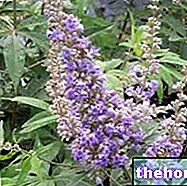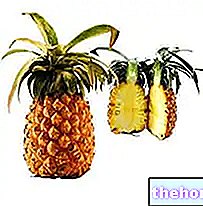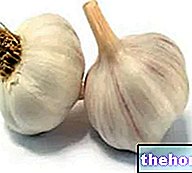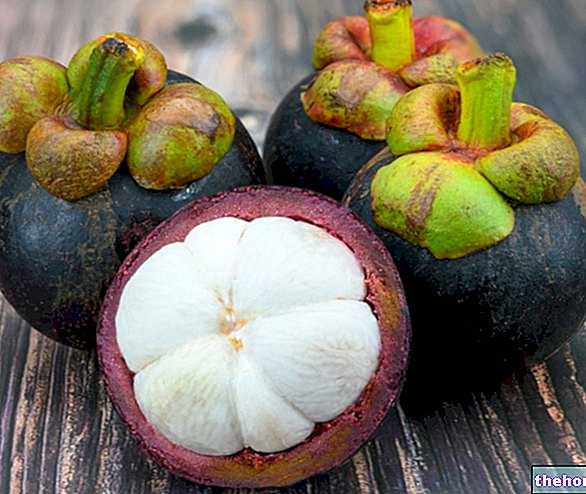By Dr. Rita Fabbri
The Fucus vesiculosus it is commonly called Brown alga but can have other names, such as Ascophyllum nodoso, Quercus Marina, bladder ruin, bladder fire, sea ruin, Bladderwrack, Black tang or more generally Kelp.
The Fucus vesiculosus it was described for the first time by Pliny, who called it "sea oak" in allusion to a certain resemblance to oak leaves. The name Fucus also derives from the Latin and we can translate it as tongues of fire.
In English bladder is bladder, while wrack is marine vegetation, but also the refusal of the sea (algae are sometimes collected and used in the countryside as fertilizer); tang etymologically means snake tongue, therefore seaweed with indented edges; Kelp is a term generally associated with different algae belonging to the genus Fucus and Laminaria, with biological properties similar to those of Fucus vesiculosus.
The brown alga is easily recognized because along the flattened fronds it is sprinkled with globular vesicles full of air, which make it float, keeping it vertical. If squeezed between the fingers, the vesicles burst making noise. brunette also has ovoid sacs containing an orange or green gelatinous substance.
Nicandro di Colofone, a Greek didactic poet, used the Fucus vesiculosus as an antidote to poisonous snake bites. Pliny recommended it for the treatment of goiter.
In 1791, in the "Experimental History of Materia Medica" regarding the "Brown Algae it is written:" ... a mixture of two pounds of juicy vesicles, collected in July, with a liter of sea water, stored in a container of glass for ten or fifteen days, it will reach the consistency of honey: it is an excellent remedy to treat laxity of the gums and for cleaning the teeth, it cleanses like a soap solution and is the best cure for the hardness and especially the decline of glandular swellings ... ".
In 1862 the doctor Duchesne-Duparc - using Fucus vesiculosus to treat psoriasis - realized that this alga acted on the metabolism of fats, so he began to use it successfully in the treatment of obesity. Indeed, the richness of iodine of the brown seaweed favors the thyroid activity, therefore this plant is currently used for the control of body weight.

Botanical name: Fucus vesicolosus L.
Family: Fucaceae
Parts used: Thallus
Botanical description
The brown alga lives along the cliffs of the medium-temperate and arctic zones (coasts of the North Sea, the Baltic Sea, the Atlantic and the Pacific). At low tide, a yellow-brown expanse appears.
Brown seaweed does not survive more than 5 or 6 hours out of water, which is why it only grows on submerged rocks.
The fronds of Fucus vesiculosus have a median vein, almost spherical vesicles full of air and reproductive swellings. The margin is smooth and the structure is dichotomous branched. Thin filaments are visible which do not have an absorbent function, but anchor to the reef.
Brown algae contains brown pigments and green pigments (chlorophyll).
Exposed to light, thanks to chlorophyll, it transforms the carbon dioxide dissolved in the water into organic substances necessary for the life of the plant.
The reproductive swellings are characterized by numerous protrusions; dissecting these swellings we note that in each protrusion there is a spherical cavity equipped with small ovoid sacs containing a gelatinous substance of orange or green color. In spring and during low tide, the gelatinous substance covers the reproductive swellings. During high tide the ovoid sacs absorb water until they “explode” releasing flagellated spermatozoids (from the orange sacks) and oospheres (from the green sacks). Following fertilization, the zygote is formed which will subsequently become a new sporophyte.
Chemical composition
Iodine (in mineral and organic form), mucopolysaccharides (such as alginic acid, fucoidan and laminarin), polyphenols including phloroglucinol, sterols including fucosterol, fucoxanthin tetraterpene, polar lipids, mineral salts and trace elements.
Therapeutic indications
Brown seaweed is commonly used in cases of obesity and overweight: its main constituent is in fact iodine, so it acts by stimulating the basal metabolism. Brown seaweed can also be used as a supplement of iodine and other trace elements.
In common preparations, the titrated dry extract is mainly used, the dosage of which varies from 500 to 900 mg per day.
The basal metabolism is linked to the thyroid function: the thyroid hormones, in fact, thyroxine (T4) and triiodothyronine (T3), intervene in the "matching" phase of mitochondrial oxidative phosphorylation, which consists in "combining" the energy released by glycolysis aerobic and anaerobic with the production of high-energy compounds (Adenosine triphosphate, Guanosine triphosphate, etc.). The greater the combination between metabolic processes and phosphorylation, the more high-energy compounds that are formed and that will be used for the synthesis of fats. The lower the combination, the greater the energy that is dissipated as heat and that is subtracted from the synthesis of lipids, especially in the adipose tissue. The iodized hormones synthesized by the thyroid speed up the basal metabolism, prevent the combination of oxidative phosphorylation, therefore increase the expenditure of energy and reduce the synthesis of lipids. This is why the brown seaweed, thanks to its mineral and organic iodine content, is commonly used to stimulate the basal metabolic rate in the reduction of body weight in obese, overweight subjects or in cases of a slowed basal metabolic rate.
We have already said that brown seaweed can also be used as a supplement of iodine and other trace elements.
The recommended daily dose of iodine is 150 µg / day. In addition to a particularly high content of iodine, the brown seaweed is rich in trace elements that can vary even substantially with the variation of the marine ecosystem where the seaweed lived; in general the most representative ions are Na, Mg, K, Ca and only in traces Zn, Pb, Ni, Mn, Hg, Cu, Co, Cd, As.
Brown algae has other pharmacological activities:
- Gastro-protective and anti-ulcer activity
the alginates present in the brown seaweed (from 15 to 45%) form a thick viscous gel that covers and protects the mucous membrane of the stomach and reduces its acid secretion. The efficacy against gastro-oesophageal reflux is also documented.
- Antidiabetic activity
Brown seaweed significantly reduces the glycemic index and the level of triglycerides in guinea pigs; this action is more evident in the diabetic animal.
- Anticoagulant activity
Fucoidan, contained in considerable quantities in brown algae, has a chemical structure correlated to that of heparin and carries out an important anticoagulant activity. However, fucoidan, administered orally, has a low systemic bioavailability.
- Antibacterial activity
The efficacy of brown algae in fighting infections with Staphylococcus aureus, Pseudomonas aeruginosa, Escherichia coli has been evaluated. The antimicrobial action is due to some marine bacteria isolated on the surface of the brown seaweed and capable of synthesizing antibiotics completely innovative as a chemical structure.
- Antiviral activity
The antiviral action is linked in particular to a series of polysaccharides and polyphenols present in the brown seaweed.
- Anti-inflammatory activity
Fucoidan has an anti-inflammatory action even in the acute phase.
- Collagenase activity
Alginates activate a glycoprotein present on the surface of fibroblasts and involved in the synthesis of collagen. Furthermore, according to a recent study, a 1% aqueous extract of brown seaweed applied locally would have shown anti-aging activity that could be exploited in numerous cosmetic formulations.
- Antioxidant activity
Some polysaccharides have an antioxidant action in vitro that could be exploited in the food industry.
Watch the video
- Watch the video on youtube
Contraindications, special warnings and appropriate precautions for use, undesirable effects
Preparations based on brown seaweed are contraindicated in case of hyperthyroidism and should in any case be taken with caution even in cases of presumed altered thyroid function or during drug treatment with thyroid hormones. It is also advisable not to take products containing brown seaweed continuously, but to carry out periodic cycles of about two months, interspersed with a temporary suspension of the treatment.
There are no known clinical studies conducted in pregnant and lactating women, however the use of brown seaweed is contraindicated in these cases. In the presence of cardiovascular disease and / or hypertension it is advisable to consult a doctor before use. Cases of allergic reactions are very rare. Overdosing can cause tremors, tachycardia, arterial hypertension.
Brown algae can have a slight laxative action due to the presence of alginates.
BIBLIOGRAPHICAL NOTES
- “… Iodine is the most important active principle in F.vesiculosus. This element used to play an important role in the treatment of obesity ... However, the use of F.vesiculosus can be considered, provided that the usual intake of iodine in our population is taken into account… The use of iodine to treat obesity can ensure the intake of the total daily requirement and, consequently, optimal thyroid function…Moro C.O. Basile G. Obesity and medicinal plants. Phytotherapy 2000; 71: s73-s82.
- Romaris-Hortas V, Garcia-Sartal C, Barciela-Alonso MC, Moreda-Pineiro A, Bermejo-Barrera P. Characterization of edible seaweed harvested on the Galician coast (northwesterrn Spain) using pattern recognition techniques and major and trace element data. J.Agric.Food Chem. 2010 Feb10; 58: 1986-92.
- Nagaoka M, Shibata H, Kimura- Takagi I, Hashimoto S, Aiyama R, Ueyama S, Yokokura T. Anti-ulcer effects and biological activities of polysaccharides from marine algae. Biofactors. 2000; 12 (1-4): 267-74.
- Hypoglycemic activity of several seaweed extracts. Lamela M, Anca J, Villar R, Otero J, Calleja JM. Journal of Ethnopharmacology 1989; 27: 35-43.
- De Azevedo TC, Bezerra ME, Santos Mda G, Souza LA, Marques CT, Benevides NM, Leite EL. Heparinoids algal and their anticoagulant, hemorrhagic activities and platelet aggregation. Biomed Pharmacother. 2009 Aug; 63: 477-83.
- Lachnit T, Wahl M, Harder T. Isolated thallus-associated compounds from the macroalga Fucus vesiculosus mediate bacterial surface colonization in the field similar to that on the natural alga. Biofouling. 2010; 26: 247-55.
- Fujimura T, Shibuya Y, Mariwaki S, Tsukahara K, Kitahara T, Sano T, Nishizawa Y, Takema Y. Fucoidan is the active component of Fucus Vesiculosus that promotes contraction of fibroblast-populated collagen gels. Biol Pharm. 2000 Oct; 23: 1180-4.
- Fujimura T, Shibuya Y, Mariwaki S, Tsukahara K, Kitahara T, Sano T, Nishizawa Y, Takema Y. Treatment of human skin with an extract of Fucus Vesiculosus changes its thickness and mechanical properties. J Cosmet Sci. 2002 Jan-Feb; 53: 1-9.
- Rocha de Souza MC, Marques CT, Guerra Dore C, Ferreira da Silva FR, Oliveira Rocha HA, Leite EL. Antioxidant activities of sulfated polysaccharides from brown and red seaweeds. J Appl Phycol. 2007 Apr; 19: 153-160.
Other articles on "Brown Alga - Properties of Fucus in Phytotherapy"
- Fucus
- Fucus in Herbalist: properties of Fucus




























